Citroen DS5 RHD 2012.5 1.G Manual PDF
Manufacturer: CITROEN, Model Year: 2012.5, Model line: DS5 RHD, Model: Citroen DS5 RHD 2012.5 1.GPages: 356, PDF Size: 10.28 MB
Page 71 of 356

69Access
Low fuel level
When the low fuel level in the tank is reached, this warning lamp comes onin the instrument panel, accompanied
b
y an audible warning and a message in the instrument panel screen.
When it first comes on, around 6 litres of fuel
remain in the tank.
You must refuel as soon as possible to avoid
running out.
Fuel supply cut-off
Your vehicle is equipped with a safety device
which cuts o
ff the fuel supply in the event of a collision.
It remains possible to use a fuel can to fill the tank.In order to ensure a good flow of fuel, do not place the nozzle of the fuel can in direct contact with the flap of themisfuel prevention device and pour slowly.
Misfuel prevention (Diesel) *
Mechanical device which prevents filling the tank of a Diesel vehicle with petrol. It avoids the risk of
engine damage that can result from filling with the wrong fuel.
Located in the filler neck, the misfuel prevention device appears when the filler cap is removed.
When a
petrol filler nozzle is introduced into the fuel filler neck of your Diesel vehicle, it comesinto contact with the flap. The system remains closed and prevents filling. Do not persist but introduce a Diesel typefiller nozzle.
Operation
Tr a v e l l i ng abroad
As Diesel fuel pump nozzles may be different
in other countries, the presence of the misfuel
prevention device ma
y make refuellingimpossible.
Before travelling abroad, we recommend that
you check with the CITROËN dealer network,
whether
your vehicle is suitable for the fuel
pumps in the country in which you want to
travel.
*
Accordin
g to country of sale.
Page 72 of 356
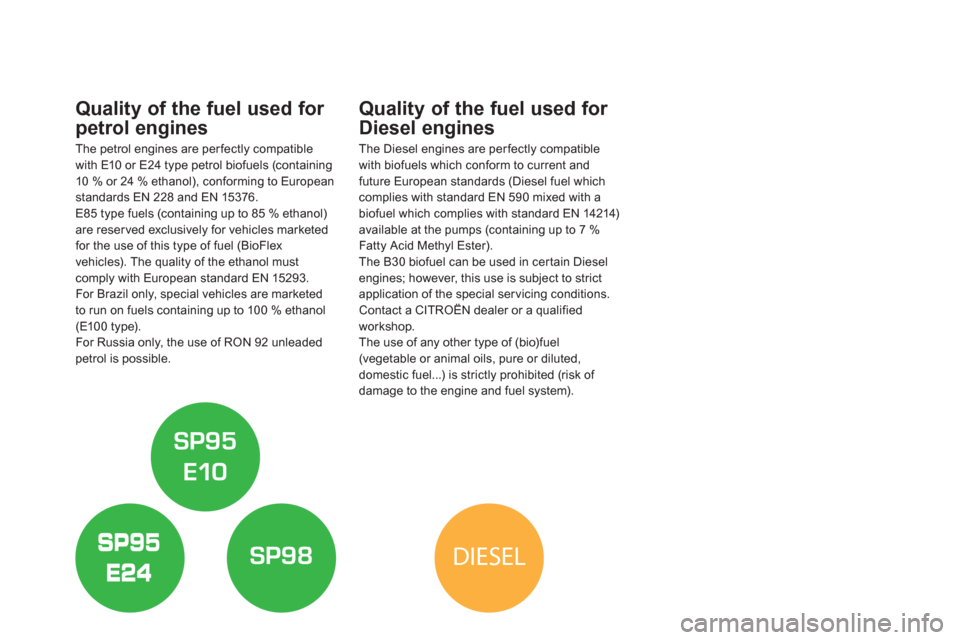
DIESEL
Quality of the fuel used for
petrol engines
The petrol engines are per fectly compatible
with E10 or E24 type petrol biofuels (containing10 % or 24 % ethanol), conforming to Europeanstandards EN 228 and EN 15376.
E85 type fuels (containing up to 85 % ethanol) are reserved exclusively for vehicles marketed for the use of this type of fuel (BioFlex
vehicles). The quality of the ethanol mustcomply with European standard EN 15293.
For Brazil only, special vehicles are marketed
to run on fuels containing up to 100 % ethanol (E10 0 type).
For Russia only, the use of RON 92 unleaded petrol is possible.
Quality of the fuel used for
Diesel engines
The Diesel engines are per fectly compatible
with biofuels which conform to current andfuture European standards (Diesel fuel whichcomplies with standard EN 590 mixed with abiofuel which complies with standard EN 14214)available at the pumps (containing up to 7 %Fatty Acid Methyl Ester).
The B30 biofuel can be used in cer tain Diesel engines; however, this use is subject to strict
application of the special ser vicing conditions.Contact a CITROËN dealer or a qualified
workshop.
The use of any other type of (bio)fuel (vegetable or animal oils, pure or diluted,
domestic fuel...) is strictly prohibited (risk of
damage to the engine and fuel system).
Page 73 of 356
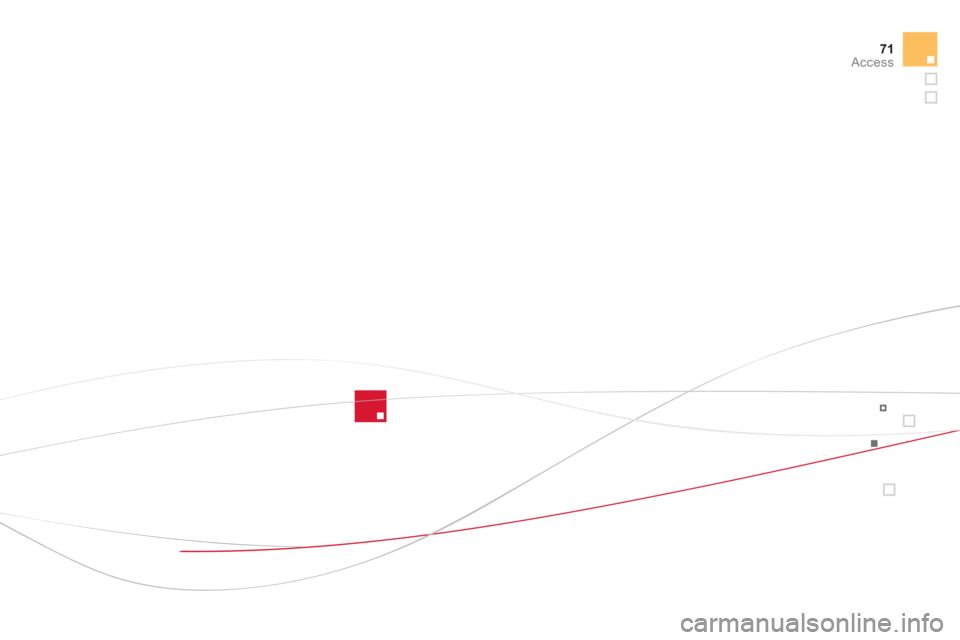
71Access
Page 74 of 356

003
Comfort
Page 75 of 356

Page 76 of 356
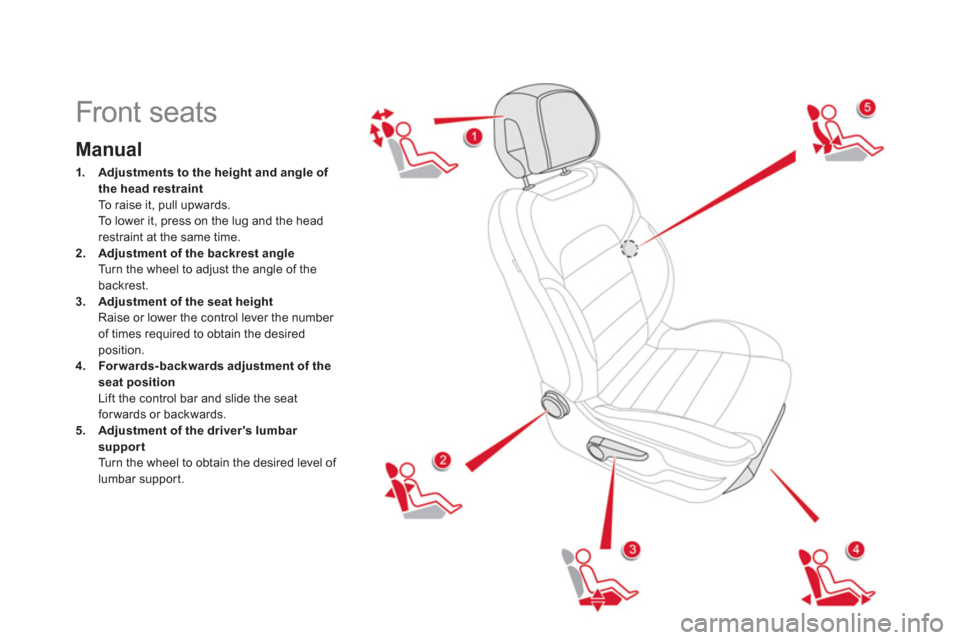
Front seats
Manual
1.Adjustments to the height and angleof
the head restraintTo raise it, pull upwards.
To lower it, press on the lug and the headrestraint at the same time.2.Adjustment of the backrest angleTurn the wheel to adjust the angle of thebackrest. 3.Adjustment of the seat heightRaise or lower the control lever the number
of times required to obtain the desiredposition.4.Forwards-backwards adjustment of the
seat position Lift the control bar and slide the seatforwards or backwards.5.Adjustment of the driver's lumbar
supportTurn the wheel to obtain the desired level of lumbar support.
Page 77 of 356
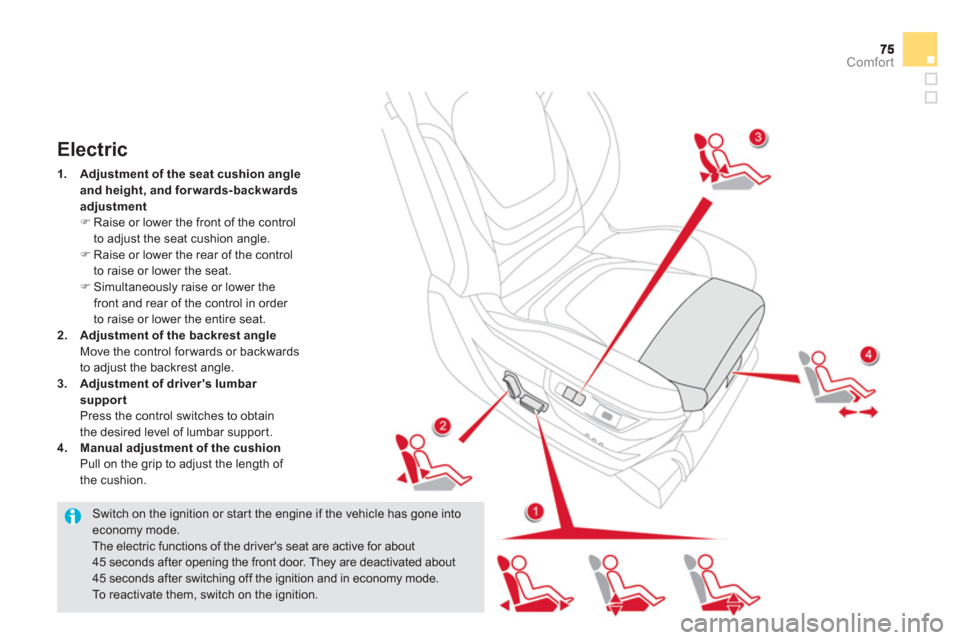
Comfort
Switch on the ignition or star t the engine if the vehicle has gone into economy mode.
The electric functions of the driver's seat are active for about 45 seconds after opening the front door. They are deactivated about 45 seconds after switching off the ignition and in economy mode.
To reactivate them, switch on the ignition.
Electric
1.Adjustment of the seat cushion angleand height, and for wards-backwards adjustment�)Raise or lower the front of the control
to adjust the seat cushion angle. �)Raise or lower the rear of the control
to raise or lower the seat.�)Simultaneously raise or lower the
front and rear of the control in order
to raise or lower the entire seat. 2.Adjustment of the backrest angle Move the control forwards or backwards
to adjust the backrest angle.
3.Adjustment of driver's lumbar
support Press the control switches to obtain
the desired level of lumbar suppor t.
4. Manual adjustment of the cushion
Pull on the grip to adjust the length of
the cushion.
Page 78 of 356

Storing driving positions
System which stores the electrical settings
of the driver's seat and the head-up display settings. It enables you to store up to
two positions using the buttons on the side of
the driver's seat.
Storing a position usingbuttons M / 1 / 2
�)
Switch on the ignition. �)
Adjust your seat and the head-up display.�)
Press button M
, then press button 1or 2within four seconds.
An audible signal indicates that the positionhas been stored.
Storing a new position cancels the previous
position.
Recalling a stored position
�)Briefly press button 1
or 2to recall the corresponding position.
An audible signal indicates the end of the
adjustment.
You can interrupt the current movementby pressing button M, 1
or 2
or by using one of the seat controls. A stored position cannot be recalled while driving. Recalling stored positions is deactivated 45 seconds after switching off the ignition.
Page 79 of 356
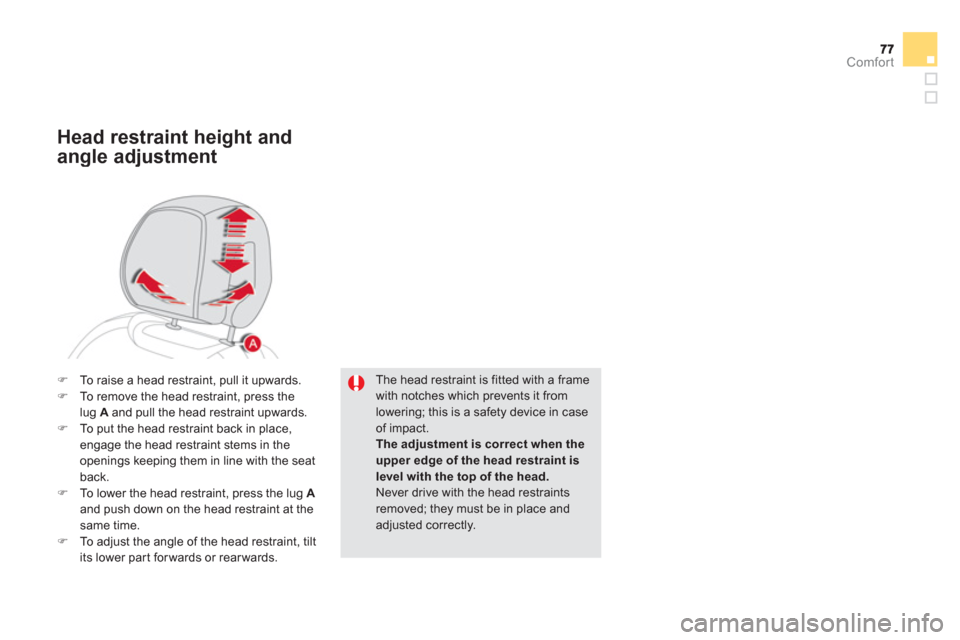
Comfort
The head restraint is fitted with a framewith notches which prevents it from lowering; this is a safety device in caseof impact.
The adjustment is correct when theupper edge of the head restraint is level with the top of the head.Never drive with the head restraints removed; they must be in place andadjusted correctly.
Head restraint height and
angle adjustment
�)To raise a head restraint, pull it upwards. �)To remove the head restraint, press thelug A
and pull the head restraint upwards. �)To put the head restraint back in place,
engage the head restraint stems in the
openings keeping them in line with the seat back. �)To lower the head restraint, press the lug Aand push down on the head restraint at thesame time. �)To a djust the angle of the head restraint, tilt
its lower part forwards or rearwards.
Page 80 of 356
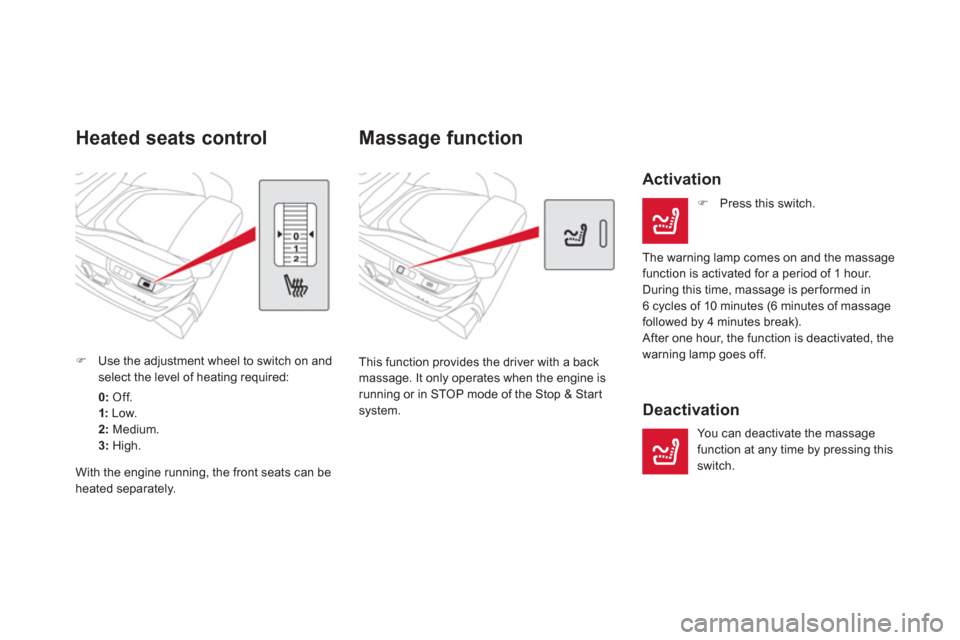
Massage function
This function provides the driver with a back
massage. It only operates when the engine is running or in STOP mode of the Stop & Start
system.
Activation
�)
Press this switch.
The warning lamp comes on and the massage function is activated for a period of 1 hour.
During this time, massage is performed in6 cycles of 10 minutes (6 minutes of massagefollowed by 4 minutes break).
After one hour, the function is deactivated, the
warning lamp goes off.
Deactivation
You can deactivate the massage function at any time by pressing this switch.
Heated seats control
�)Use the adjustment wheel to switch on and
select the level of heating required:
0:
Off. 1:Low.2:Medium.3:
High.
With the en
gine running, the front seats can beheated separately.